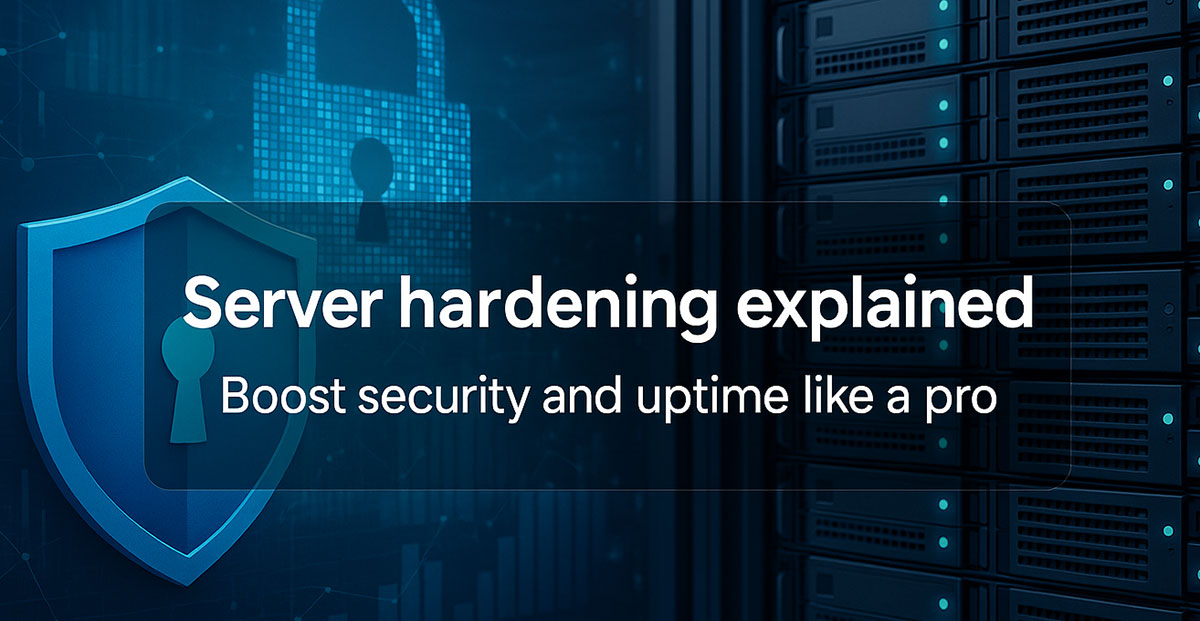 Why Server Hardening Is Essential Today
Why Server Hardening Is Essential Today
In today’s digital landscape, servers face relentless threats, making server hardening an essential defense strategy. Without this protection, cybercriminals exploit weak configurations, outdated systems, and human error to breach IT environments. For instance, ransomware can paralyze healthcare systems, while on the other hand, botnets may take down e-commerce platforms. Ultimately, just one unprotected server has the potential to jeopardize your entire operation.
This is exactly where implementing robust security measures becomes critical. Essentially, it involves systematically securing your server to minimize vulnerabilities, thereby ensuring business continuity, reducing downtime, and protecting sensitive data. Consequently, a well-secured server doesn’t just resist attacks-it also supports uptime and long-term stability.
Securing Your Server Against Threats
Put simply, securing your infrastructure starts with minimizing a server’s attack surface by removing unnecessary services, disabling insecure features, and tightening configurations. In other words, the primary goal is straightforward: make your server lean, secure, and reliable.
By default, a server setup often includes numerous open ports, enabled services, and weak security settings-vulnerabilities that cyber attackers are quick to exploit. That’s why hardening is essential; it removes these weak points before they eventually develop into serious security problems.
Example vulnerabilities in default servers:
- Open ports for legacy services like Telnet.
- Default administrator passwords left unchanged.
- Unused but active services exposing sensitive data.
Core Elements of Server Hardening
- Secure Network Configurations
- Restrict traffic using firewalls like iptables (Linux) or Windows Defender Firewall.
- Isolate critical systems through network segmentation and VPNs.
- Block all unnecessary inbound and outbound connections.
- Tighten User Access Controls
- Grant the least privilege necessary for each user.
- Use strong passwords or, better yet, SSH key-based logins.
- Enforce account lockouts, session timeouts, and 2FA.
- Manage File & Directory Permissions
- Set strict permissions for critical system files.
- Regularly audit file access and changes to prevent tampering.
- Remove Unnecessary Software
- Delete unused packages and services.
- To begin with, ensure all installed applications are sourced from trusted providers and verified repositories to safeguard your server environment.
Operating System Hardening Tips
Linux Servers:
- Disable unused daemons and protocols.
- Enable SELinux or AppArmor for enhanced system protection.
- Configure SSH for key authentication on non-standard ports.
Windows Servers:
- Disable legacy protocols like SMBv1.
- Apply strict Group Policies and patch regularly via Windows Update.
- Lock down local security policies.
Regardless of the platform you use, regular patching is essential to fix newly discovered vulnerabilities. Therefore, schedule updates and automate them wherever possible to maintain strong security.
Deploy Firewall, IDS, and Endpoint Security
While it’s true that firewalls serve as the initial barrier against threats, they alone are insufficient for complete system security. To strengthen your defenses further, deploy Intrusion Detection Systems (IDS) like Snort or OSSEC to monitor network traffic and logs for signs of attack.
In addition, pair these measures with endpoint security solutions that block malware, ransomware, and unauthorized access attempts-thereby creating a multi-layered defense against evolving threats.
Control Authentication and Access
Prevent unauthorized access by:
- Enforcing strong, regularly rotated passwords.
- Using Role-Based Access Control (RBAC) to limit what users can do.
- Following the Principle of Least Privilege to minimize potential damage if an account is compromised.
Furthermore, by implementing SSH key-based authentication, remote access is fortified, thereby rendering brute-force attacks virtually ineffective.
Patch Management: Close Security Gaps
Unpatched servers are the most common cause of breaches. Automate updates using tools like:
- WSUS for Windows
- Yum-cron or Unattended Upgrades for Linux
To avoid disruptions, test updates in a staging environment first. Once verified, apply patches quickly to minimize exposure and strengthen your server’s security posture.
Audit, Monitor, and Log Everything
Equally important, real-time monitoring helps detect and stop breaches before damage spreads. For effective results, use tools like Logwatch, Graylog, or the ELK Stack for centralized log analysis.
To further enhance your defenses, automate protection with tools like Fail2Ban, which blocks IP addresses after repeated login failures. Moreover, tools such as AIDE and Tripwire monitor file integrity, thus providing early detection of unauthorized alterations within the system.
Harden Beyond the Operating System
Applications and databases also need protection:
- For web servers like Apache or Nginx: disable directory listings, enforce HTTPS, and remove unused modules.
- For databases like MySQL or PostgreSQL: disable remote root access, remove test databases, and encrypt connections.
APIs should include input validation, rate limiting, and token-based authentication to prevent misuse.
Compliance and Industry Standards
Server hardening also helps meet regulatory requirements such as HIPAA, GDPR, and PCI-DSS, which mandate strong security controls.
Frameworks like CIS Benchmarks and NIST SP 800-123 provide actionable guidelines for securing your systems to meet compliance and audit requirements.
Automate Hardening for Scalability
As your server environment grows, manual hardening quickly becomes unmanageable. To address this challenge, tools like Ansible, Puppet, and Chef automate secure configuration deployment across hundreds of servers. Moreover, Infrastructure as Code (IaC) helps standardize these configurations and, in case of errors, allows for easy rollback.
actsupport secures your servers against vulnerabilities and downtime.
Stay protected, stay online-trust our server hardening expertise.
Make Server Hardening an Ongoing Process
Clearly, server hardening is not a one-time task. As time progresses, threats advance, systems undergo changes, and configurations can deviate from their intended secure baseline. Therefore, make server hardening part of your IT culture through regular audits, continuous monitoring, and team training.
In the end, a proactive, hardened server environment keeps your systems online, your data protected, and your business resilient against today’s aggressive cyber landscape.Stay updated! Follow us on social media! Facebook, Twitter, LinkedIn
Check out our newest blog entry (IAM-TOTP: The Future of Access Control)
Free Blog Tips in Your Inbox




